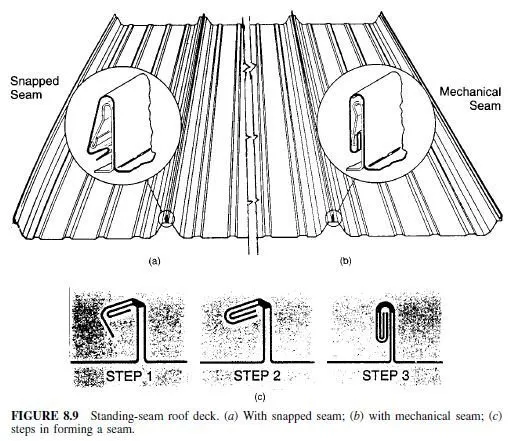Steel-framed buildings often utilize a roof deck composed simply of metal deck. When properly sloped for drainage, the metal deck itself can serve as a watertight enclosure. Alternatively, roofing materials can be placed on top of the deck. In either case, diaphragm action can be achieved by proper sizing and attachment of the metal deck. A fire rating can be provided by applying spray-on fire protection to the underside of the roof deck, or by installing a fire-rated ceiling system below the deck.
Metal roof deck usually is used for noncomposite construction. It is commonly available in depths of 11â„2, 2, and 3 in. Long-span roof deck is available with depths of 41â„2, 6, and 71â„2 in from some manufacturers. Cellular roof deck is sometimes used to provide a smooth soffit. When a lightweight insulating concrete fill is placed over the roof deck, the deck should be galvanized and also vented (perforated) to accelerate the drying time of the insulating fill, and prevent entrapment of water vapor.
Standing-Seam System. When the metal roof deck is to serve as a weathertight enclosure, connection of deck units with standing seams offers the advantage of placing the deck seam above the drainage surface of the roof, thereby minimizing the potential for water leakage (Fig. 8.9). The seams can simply be snapped together or, to enhance their weathertightness, can be continuously seamed by mechanical means with a field-operated seaming machine provided by the deck manufacturer. Some deck types utilize an additional cap piece over the seam, which is mechanically seamed in the field (see Fig. 8.10). Frequently, the seams contain a factory-applied sealant for added weather protection.
Thicknesses of standing-seam roof decks usually range between 26 and 20 ga. Typical spans range between 3 and 8 ft. A roof slope of at least 1â„4 in per ft should be provided for drainage of rainwater.
Standing-seam systems are typically attached to the supporting members with concealed anchor clips (Fig. 8.11) that allow unimpeded longitudinal thermal movement of the deck relative to the supporting structure. This eliminates buildup of stresses within the system and possible leakage at connections. However, the effect on the lateral bracing of supporting members must be carefully evaluated, which may result in a need for supplementary bracing.
An evaluation method is presented in the American Iron and Steel Institutes Specification??for the Design of Cold-Formed Steel Structural Members. (See Art. 10.12.4.)




